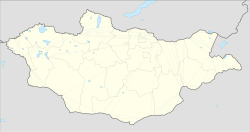|
Darkhan (city)
 Darkhan (/ˈdɑːrkɑːn/, UK also /ˈdɑːrhæn/; Mongolian: Дархан, [ˈtarχɴ̩]) is the third-largest city in Mongolia and the capital of Darkhan-Uul Aimag. HistoryOn October 17, 1961, the city of Darkhan was built with extensive economic assistance from the Comecon.[1] As its name implies, the city was originally conceived to be a manufacturing site for Mongolia's northern territory. Polish specialists built a woodworking plant, brickworks and a lime factory in Darkhan.[1] Hungarians built a meat factory, opened in 1974.[2] In 1985, the city housed the tallest building in the country when a 16-story apartment was opened.[3] The city remains a mostly industrial centre and is the home of some 82% of Darkhan-Uul Province's population. As with most urban Mongols, some 86% of the city's population live in residential apartments, with the remaining population living in yurts (gers) on the outskirts of the city.[citation needed] GeographyWith an elevation of 665 metres or 2,182 feet, Darkhan is the capital of the Darkhan-Uul Province. It is a city with notable Soviet influence, evidenced by the huge square buildings and heavy Cyrillic usage. Darkhan is surrounded by mountains and hills, also having some tourist attractions like statues largely being Buddhist attractions. Some parts of the city have wooden houses.[4][5] The Kharaa River passes through the western edge of the city. ClimateDarkhan has a borderline humid continental climate (Dwb), close to the more typical subarctic climate (Dwc) of northern Mongolia, which is found in higher areas near the city, and only marginally wet enough to avoid qualifying as a semi-arid climate (BSk). These three climate types tend to overlap a good deal over the border regions of Mongolia, Russia and Kazakhstan.[6] This area has extremely cold and dry winters; however the summers are warmer and more humid.
EconomyThe main industry of Darkhan is coal mining. It has also several heavy industries, such as metallurgy, chemical and construction.[8] Culture The Kharagiin monastery is housed in a log cabin in the old town; it has recently become active again as a Buddhist monastery. In addition, the city hosts the Museum of Darkhan-Uul Province. This museum, also called the Traditional Museum of Folk Art, contains a collection of archaeological findings, traditional clothing, religious artifacts, and taxidermy. The city has a monument to the horse-head fiddle (morin khuur), the national emblematic instrument of Mongols. EducationDarkhan is the second largest educational center in Mongolia, making the educational level of the city's population very high. Hundreds of students come to Darkhan from other parts of Mongolia to study. Currently in Darkhan Uul Aimag there are 10 higher education institutions, 25 secondary schools, 14 kindergartens, the Institute of Management and Development, the Regional Business Development Center and the Plant Science and Agricultural Training Research Institute. Politics Darkhan houses the Ministry of Food, Agriculture and Light Industry.[9] Infrastructure The city is powered by the Darkhan Thermal Power Plant. Waste water is treated at the Darkhan Wastewater Treatment Plant before being discharged to the nearby river. Tourist attractionsTransportation Darkhan is served by the Darkhan-1 railway station in the north and Darkhan-2 railway station in the south.[10] Darkhan is connected by four-lane road to Ulaanbaatar for a length of 204 km along the AH3.[11] Partner citiesDarkhan is partnered with:[12]
References
Wikimedia Commons has media related to Darkhan (city). Wikivoyage has a travel guide for Darkhan. |
||||||||||||||||||||||||||||||||||||||||||||||||||||||||||||||||||||||||||||||||||||||||||||||||||||||||||||||||||||||||||||||||||||||||||||||||


